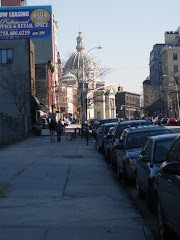Now, not only are you able to switch to a close-up aerial view of any part of Brooklyn from today (actually, 2008), but you can also call up a view of the same area from 1924!!
Granted, the 1924 view is not as good as the contemporary one. The photos are black & white and the detail isn't as good, but you can definitely see the differences across the years.
You can see what the borough looked like before the Brooklyn-Queens Expressway was built, before the Verrazano Bridge was built, before some major buildings were thrown up, before the Robert Moses-inspired urban renewal replaced dense neighborhoods with towering projects.
I've placed a few 1924 vs. 2008 photos here just to give you an idea of what the 1924 map looks like. And here you definitely have to click on the photo to enlarge it in order to see any detail.
First a view above McCarren Park in Greenpoint, along Bedford and Driggs Avenues and Lorimer Street, The park is there in 1924 but the pool (the largest municipal pool in the city, I think, when it opened) is about a dozen years in the future; it will occupy the white trapezoidal shaped area north of the park in the 1924 view; just to the right of the Lorimer St. label in 2008. Automotive High School, just west of the park on Bedford Avenue wasn't built until 1937 (it's the "L"-shaped building just above the "Mc" in 2008). And you see that Greenpoint itself was much more industrial in those days, note all the above ground storage tanks dotting the area and more working piers (both of these more evident in the area of Greenpoint off the photo further north).


The view over Fort Greene Park isn't a great deal different except that what had been a dense neighborhood in 1924 along the Myrtle Avenue side of the park is today the site of more New York City housing projects (the "slum" to the right of the 12D label in 1924). And . . . no BQE above Park Ave. at the top of the map.

 A short sidelight on that area. I happened to be over there one Saturday last autumn taking pictures of one of the surviving Carnegie libraries on St. Edward's Street and also decided to take some shots of a very imposing Catholic church directly across the street from it. On the old map the church would be directly under the 12D label (the library is shown just to the right of the "D"). I got into conversation with an elderly man who was passing by and he asked if I knew what was curious about the church. When I said no, he told me that Al Capone had been baptized there. I had never given any thought to where Al Capone was born, probably thinking it was in Chicago. It turns out he was born only a few blocks away at 95 Navy Street (the family moved to Park Slope when he was 11). This invaluable map lists the church as dating from 1920 so either the date is wrong or the church was rebuilt. Since I've known other incorrect dates on the map, that doesn't surprise me.
A short sidelight on that area. I happened to be over there one Saturday last autumn taking pictures of one of the surviving Carnegie libraries on St. Edward's Street and also decided to take some shots of a very imposing Catholic church directly across the street from it. On the old map the church would be directly under the 12D label (the library is shown just to the right of the "D"). I got into conversation with an elderly man who was passing by and he asked if I knew what was curious about the church. When I said no, he told me that Al Capone had been baptized there. I had never given any thought to where Al Capone was born, probably thinking it was in Chicago. It turns out he was born only a few blocks away at 95 Navy Street (the family moved to Park Slope when he was 11). This invaluable map lists the church as dating from 1920 so either the date is wrong or the church was rebuilt. Since I've known other incorrect dates on the map, that doesn't surprise me.Bay Ridge and Fort Hamilton, 2008.
 Bay Ridge and Fort Hamilton, 1924. Hey, dude, where's my bridge!?!
Bay Ridge and Fort Hamilton, 1924. Hey, dude, where's my bridge!?!
East Williamsburg, the site of the Williamsburg Houses that in 1939 were the largest slum-clearance and low-income housing project of the Federal Housing Project (Stagg Walk and Ten Eyck Walk), according to the 1939 WPA Guide to New York City. Whenever New York City wanted to raze a neighborhood and throw up some projects they brought out the word "slum"; that's all it took and you were out of there, too often left on your own to find other accommodation. They were designated a city landmark in 2003.
 A government report of the 1930s reportedly described the slums of the Williamsburg area of Brooklyn as bearing "the stamp of dull listlessness and despair." I can't imagine such government poetry today.
A government report of the 1930s reportedly described the slums of the Williamsburg area of Brooklyn as bearing "the stamp of dull listlessness and despair." I can't imagine such government poetry today.
And there really were honest-to-goodness Navy ships in the Brooklyn Navy Yard in 1924.


That 1924 map looks like something you'd see in a Warner Bros. World War II thriller like All Through the Night, where Humphrey Bogart is trying to thwart the Fifth Columnists, or "Fivers," as he calls them, trying to blow up a ship in the Brooklyn Navy Yard, or where Norman Lloyd tried to blow up the ship near the end of Hitchcock's Saboteur (Universal not Warner's, before someone jumps down my throat about it).

